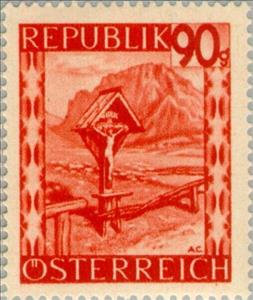Stamp: Wayside cross near Tragöss (Steiermark) (Austria 1947)
Wayside cross near Tragöss (Steiermark) (Austria 1947)
10 December (Austria ) within release Landscapes goes into circulation Stamp Wayside cross near Tragöss (Steiermark) face value 90 Austrian groschen
| Stamp Wayside cross near Tragöss (Steiermark) in catalogues | |
|---|---|
| Michel: | Mi:AT 849 |
| Yvert et Tellier: | Yt:AT 707A |
Stamp is vertical format.
Also in the issue Landscapes:
- Stamp - Lermoos (Tyrol) face value 3;
- Stamp - Leopoldsberg (Vienna) face value 5;
- Stamp - Hochosterwitz (Carinthia) face value 10;
- Stamp - Forchtenstein Castle (Burgenland) face value 15;
- Stamp - Chapel at Gebhardsberg (Vorarlberg) face value 20;
- Stamp - Neusiedler Lake (Burgenland) face value 30;
- Stamp - Mariazell (Styria) face value 40;
- Stamp - Silvretta mountain range (Vorarlberg) face value 50;
- Stamp - Semmering (Lower Austria) face value 60;
- Stamp - Badgastein (Salzburg) face value 70;
- Stamp - Kaisergebirge (Tyrol) face value 80;
- Stamp - Wayside cross near Tragöss (Steiermark) face value 90;
- Stamp - Dürnstein (Lower Austria) face value 1;
- Stamp - St. Christoph at Arlberg (Tyrol) face value 2;
- Stamp - Heiligenblut (Kärnten) face value 3;
- Stamp - Schönbrunn, palace gardens with gloriette (Vienna) face value 5;
Stamp Wayside cross near Tragöss (Steiermark) it reflects the thematic directions:
A landscape is the visible features of an area of land, its landforms and how they integrate with natural or man-made features. A landscape includes the physical elements of geophysically defined landforms such as (ice-capped) mountains, hills, water bodies such as rivers, lakes, ponds and the sea, living elements of land cover including indigenous vegetation, human elements including different forms of land use, buildings and structures, and transitory elements such as lighting and weather conditions. Combining both their physical origins and the cultural overlay of human presence, often created over millennia, landscapes reflect a living synthesis of people and place that is vital to local and national identity. The character of a landscape helps define the self-image of the people who inhabit it and a sense of place that differentiates one region from other regions. It is the dynamic backdrop to people’s lives. Landscape can be as varied as farmland, a landscape park, or wilderness. The earth has a vast range of landscapes, including the icy landscapes of polar regions, mountainous landscapes, vast arid desert landscapes, islands and coastal landscapes, densely forested or wooded landscapes including past boreal forests and tropical rainforests, and agricultural landscapes of temperate and tropical regions.
Religion is any cultural system of designated behaviors and practices, world views, texts, sanctified places, ethics, or organizations, that relate humanity to the supernatural or transcendental. Religions relate humanity to what anthropologist Clifford Geertz has referred to as a cosmic "order of existence". Different religions may or may not contain various elements ranging from the "divine", "sacred things", "faith", a "supernatural being or supernatural beings" or "some sort of ultimacy and transcendence that will provide norms and power for the rest of life". Religious practices may include rituals, sermons, commemoration or veneration (of deities), sacrifices, festivals, feasts, trances, initiations, funerary services, matrimonial services, meditation, prayer, music, art, dance, public service, or other aspects of human culture. Religions have sacred histories and narratives, which may be preserved in sacred scriptures, and symbols and holy places, that aim mostly to give a meaning to life. Religions may contain symbolic stories, which are sometimes said by followers to be true, that have the side purpose of explaining the origin of life, the Universe and other things. Traditionally, faith, in addition to reason, has been considered a source of religious beliefs. There are an estimated 10,000 distinct religions worldwide. About 84% of the world's population is affiliated with one of the five largest religions, namely Christianity, Islam, Hinduism, Buddhism or forms of folk religion.


